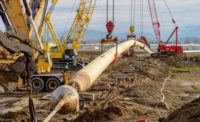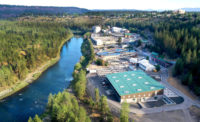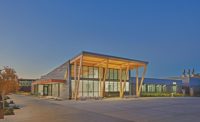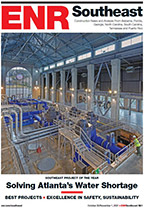Bull Run Dam 2 Towers Improvements Project, Sandy, Ore.
This infrastructure improvement project occurred within the Bull Run Watershed, the nation's purest natural drinking water reservoir. The watershed has been federally protected since 1892 and serves 900,000 people in Portland and its vicinity.
The $31-million project involved the installation of a 120-ft-high selective withdrawal structure on the existing North Intake Tower at Dam No. 2. The structure, or "wet well," allows operators to remove water from three different elevations within the reservoir. It is delivered to the Bull Run River at the rate and temperature necessary to support fish populations and to water conduits to continue the availability of high-quality drinking water.
The wet well, which was constructed mostly under water, allows releases up to 2,000 cu ft per second and features six additional ballasted emergency relief gates designed as a passive device to automatically open in the event that water height differential outside and inside the wet well exceed 5.5 ft.
Using a construction manager/general contractor method and three-dimensional modeling, the team addressed several connection details. This helped it avoid the usual challenges encountered in retrofit work, says Black & Veatch, the lead design firm.
For example, physical, 3D and other technical modeling allowed the design team to test and observe proposed tower improvements to ensure that objectives were met. The wet well, which was originally designed to be constructed in 12 modules, was built in only nine, thus saving time, costs, carbon emissions and splice connections.
Black & Veatch credits the modeling, partnering, constant communication and excellent planning in allowing the team to overcome other challenges associated with working within an active, potable water reservoir.
The firm says the project's biggest risk was the potential for fouling of the water supply. The drinking water from the watershed is not filtered—the water receives chlorination only prior to distribution.
The team took great care to disinfect all equipment entering the watershed, which can receive up to 130 in. of rain annually. This included putting roofs and structures over stationary equipment and daily management of rainwater containment pans.
The team also deployed a 125-ft-deep turbidity curtain that was nearly a quarter mile long to encompass the work area. As a result, the team delivered the project on time and on budget while Portland's drinking water remained uninterrupted.
The judges took note of how well the team coordinated efforts in a highly regulated area as well as its use of the CM/GC approach and digital technology.
Key Players
Owner/Developer City of Portland, Water Bureau
General Contractor Advanced American Construction Inc.
Lead Design Firm Black & Veatch Corp.







